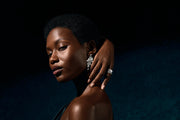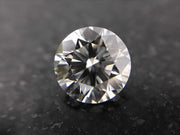Photo: Rich Dieckhoff
August 31, 2021 by Natalie Sportelli
Launched in January 2020, Aether Diamonds creates luxury jewels by sucking carbon pollution from the air. We chat with cofounder Ryan Sherman to go inside the brand and learn more about ecommerce's growing hold on the wedding industry.
It's no secret that the wedding industry has been slow to come online. As one founder of a direct-to-consumer bridal brand put it, weddings are a "last respite for the brick and mortar experience.” But the forces behind the pandemic didn't miss the engagement ring sector, set to reach nearly $40 billion in the next six years.
Filling the void left by in-person sales reps are a number of new brands seeking to offer a full-service digital experience for choosing your dream ring. A couple to note include personalized ring makers Frank Darling and The Clear Cut; Eterneva, which produces rings and jewelry from loved ones' ashes; and Aether Diamonds, a brand that captures carbon pollution from the atmosphere for its stones.
Launched in December 2020, lab-grown Aether Diamonds creates carbon-negative rings, necklaces, and bracelets. The company says that for every carat of diamonds sold, it removes 20 metric tons of harmful Co2 from the air. (As a comparison, the average American produce 16 metric tons per year.)
Thingtesting caught up with Aether Diamonds to learn more about what consumers already know (and are still learning) about lab-grown diamonds, ecommerce's growing hold on the wedding industry and where the lab-grown space is headed.
Thingtesting: What opening did you see in the lab-grown diamond space when you were developing Aether?
Ryan Shearman: Initially, I recognized the fact that lab-grown diamonds were a step in the right direction compared to mined diamonds – the supply chain issues with mined diamonds, the human rights abuses, the environmental toll that are pretty well-known at this point. Most folks look at lab-grown and maybe paint it with a sustainable brush just out of the box, because it doesn't come from the ground. But that doesn't mean it is really sustainable, and that was something that didn't really sit well with me.
In addition, at the same time, you have this dynamic in hand where luxury brands aren't adopting lab-grown because regular lab-grown diamonds have been positioned by the big mining companies' aggressive marketing efforts as a lower quality, inferior option. And if you're a luxury consumer who wants something that is truly sustainable, something that can drive benefit to the environment, that didn't exist in the market.
TT: What kind of education have you had to do around the lab-grown diamond space?
RS: Consumers are much more educated about lab-grown [diamonds] today than they were when we started the company three years ago, or when I first started paying attention to lab-grown probably eight years ago. A lot of that education hurdle is behind us firms. For some segments of the market, there are still people who are are educating themselves, but now at least, the industry has become more educated.
I remember the end of my tenure at David Yurman [in 2013], talking to people in the industry who hadn't even heard about lab-grown diamonds yet, and that wasn't all that long ago. So to have pretty much everyone understand it to some degree, where you can pop into your local jeweler and there's someone there who can explain to you a little bit more, about what the difference between lab-grown diamond and a mined diamond is, that's imperative. You need that if you're going to educate consumers. So now that the industry is there, there's less of a lift that falls on us as a company.
TT: What are consumers still looking to understand?
RS: One of the things that we'd like to focus on for consumers: they say, 'Well what's the difference? This is a lab-grown diamond, is it rare, is it as good?' Lab-grown diamonds are atomic carbon. They are, generally speaking, the same atomic structure that makes them as a mined diamond. The difference being that lab-grown are actually a much smaller volume of the market – they are, in fact, rarer than diamonds – the other difference being that at some point, there will be no more diamonds coming from the ground, and lab-grown can continue to be made.
TT: What impact has the pandemic had on the diamond industry, from your perspective?
RS: Generally speaking, COVID-19 was good for the jewelry sector, even better for the bridal segment of the jewelry industry. COVID was an accelerant for relationships, so this was either something that caused relationships to fizzle and peter out or take it to the next step. And then oftentimes that means getting engaged, cohabitating, whatever it might be, and we weren't able to go down to the local mom and pop jeweler and take a look at a piece of diamond jewelry because those stores were all closed. It forced people's hands and forced people to go and shop online, so the percentage of consumers that were shopping online pre-pandemic versus during and now post-pandemic has changed quite a bit, which is great. At the end of the day, it's not really that different from a lot of other categories that have already made the shift to ecommerce.
[For] engagement rings pre-pandemic, it was maybe 14% or 15% of the market buying it online. Depending on how all of the data shakes out, once it's been collected and analyzed, everyone I'm talking to says it's hopefully at least doubled since then. And to see a very slow ramp up to get to that 14% or 15% range over the better part of a decade and then have that double in a year, that's quite material.
We have to step back and understand that that is a change, and I don't think it's a change that's going anywhere. We're not going to go back to the way it was. People are still going to go in and look at rings at their local store, there'll be some correction factor. But ecommerce in the bridal segment is here to stay.
TT: What should consumers look out for in the lab-grown diamonds space in the next year?
RS: It's still a bit of the Wild West, there isn't a single category leader just yet. Unlike the mined diamond world that has been heavily dominated by largely one company in recent decades, now it's a small handful, you have a much wider and broader collection of companies that are dabbling in lab-grown and people are trying to find their way.
For us, we're really excited about where we've positioned ourselves as a luxury offering, because you know now this discerning higher-end customer who really does care about the impact of their purchases, there is nothing else in the market for them that can check that box. We hope by virtue of the way we're approaching the problem that will align with consumers. But I do think we're going to start to see several breakout brands emerge in the next year or two, and we hope to be one of them.




